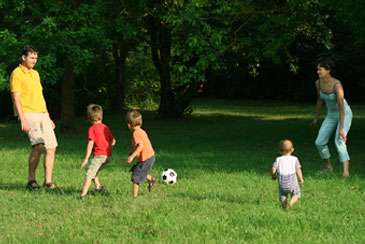Landscaping with a Green Thumb: The Organic Lawn

In this article, you will find:
Lawn is for playing
Landscaping with a Green Thumb: The Organic Lawn
Tired of spending hours on your lawn? Worried about using chemicals in areas where your children and pets play? Ready to do your part for the environment? Then it's time to rethink the size of your lawn and the way that you care for it. These tips will help you get started.
Resize Your Lawn
For many Americans, a manicured rolling green lawn is what "the yard" is all about. However, lawns are the most unnatural part of the landscape. The "perfect" lawn requires regular mowing, watering during dry spells, and lots of chemicals: fertilizers, pesticides, weed killers, and more.
Increasingly, people are deciding to minimize their lawn, replacing it with paths and garden beds filled with plants, shrubs, and ground cover. They then "go natural" with the lawn that remains, allowing it to become a safe and healthy play area for their kids and pets.
Turning Lawn into a Flower Bed
If you wish to replace part of a well-established lawn with flower beds, you will need to get rid of the grass. The labor-intensive approach would be to dig up all the sod by hand, which has the unfortunate side-effect of removing some good topsoil. If you can be patient and wait for next season, you can have enriched, moist soil ready in the spring by following these steps:
- Decide on the placement of the flower bed(s). You may want to use a can of spray paint to help you visualize their size and shape. You could also lay out a hose in the shape of each desired bed.
- Mow the grass in the proposed flower bed areas as short as possible.
- Cover each designated bed with black plastic, and pin the edges down well with stones or metal "earth staples" (available at nurseries and garden centers). The plastic will block both sun and water, effectively killing the grass (as well as any weeds) over the course of the summer months.
- In the fall, remove the plastic and put temporary chicken wire fencing around each bed. Fill each chicken wire "container" to the top with fallen leaves.
- In the spring, remove the fencing and any undecomposed leaves. The ground should be moist and relatively easy to dig.
- Loosen the first six to eight inches of the soil, incorporating the decomposed leaves and two to three inches of compost or well-aged manure. Let the bed rest for a few days, then start planting.

